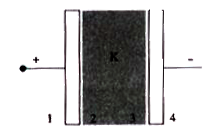A capacitor of capacitance C is charged to a potential V. The flux of the electric field through a closed surface enclosing the capacitor is
CVε
2CVε0
CV2esψlon0
zero
The correct Answer is:D
To solve the problem, we need to determine the electric flux through a closed surface that encloses a charged capacitor. Here’s a step-by-step solution:
Step 1: Understand the Concept of Electric Flux
Electric flux (Φ) through a closed surface is defined by Gauss's law, which states that the electric flux through a closed surface is equal to the total charge (Q) enclosed by that surface divided by the permittivity of free space (ε₀):
Φ=Qϵ0
Step 2: Identify the Charges in the Capacitor
A capacitor consists of two plates: one with a positive charge (+Q) and the other with an equal but negative charge (-Q). When the capacitor is charged to a potential V, the total charge on the capacitor is Q.
Step 3: Determine the Total Charge Enclosed
When we consider a closed surface that completely encloses the capacitor, we need to calculate the total charge enclosed by that surface. Since the positive charge on one plate is +Q and the negative charge on the other plate is -Q, the total charge enclosed (Q_enclosed) is:
Qenclosed=+Q+(−Q)=0
Step 4: Apply Gauss's Law
Now we can substitute the total charge enclosed into the equation for electric flux:
Φ=Qenclosedϵ0=0ϵ0=0
Conclusion
Thus, the electric flux through a closed surface enclosing the capacitor is:
Φ=0
Final Answer
The correct option is 0.
---
Electric flux (Φ) through a closed surface is defined by Gauss's law, which states that the electric flux through a closed surface is equal to the total charge (Q) enclosed by that surface divided by the permittivity of free space (ε₀):
Φ=Qϵ0
A capacitor consists of two plates: one with a positive charge (+Q) and the other with an equal but negative charge (-Q). When the capacitor is charged to a potential V, the total charge on the capacitor is Q.
When we consider a closed surface that completely encloses the capacitor, we need to calculate the total charge enclosed by that surface. Since the positive charge on one plate is +Q and the negative charge on the other plate is -Q, the total charge enclosed (Q_enclosed) is:
Qenclosed=+Q+(−Q)=0
Now we can substitute the total charge enclosed into the equation for electric flux:
Φ=Qenclosedϵ0=0ϵ0=0
Thus, the electric flux through a closed surface enclosing the capacitor is:
Φ=0
The correct option is 0.
Topper's Solved these Questions
- CAPACITORSBook:HC VERMA ENGLISHChapter:CAPACITORSExercise:OBJECTIVE 2
Explore 6 Videos
- CAPACITORSBook:HC VERMA ENGLISHChapter:CAPACITORSExercise:Exercise
Explore 65 Videos
- CAPACITORSBook:HC VERMA ENGLISHChapter:CAPACITORSExercise:worked out examples
Explore 23 Videos
- BOHR'S MODEL AND PHYSICS OF THE ATOMBook:HC VERMA ENGLISHChapter:BOHR'S MODEL AND PHYSICS OF THE ATOMExercise:Short Answer
Explore 10 Videos
- DISPERSION AND SPECTRABook:HC VERMA ENGLISHChapter:DISPERSION AND SPECTRAExercise:Question for short Answer
Explore 6 Videos
Similar Questions
If the flux of the electric field through a closed surface is zero,
View SolutionThe net flux passing through a closed surface enclosing unit charge is
View SolutionA capacitor of capacitance C is connected to a cell of emf V and when fully charged, it is disconnected. Now the separation between the plates is doubled. The change in flux of electric field through a closed surface enclosing the capacitor is
View SolutionA parallel plate capacitor of capacitane C is charged to a potential V. It is then connected to another uncharged capacitor with the same capacitance. Find out the ratio of the energy stored in the combined system to that stored initially in the single capacitor.
View SolutionAn isolated capacitor of capacitance C is charged to a potential V. Then a dielectric slab of dielectric constant K is inserted as shown. The net charge on four surfaces 1,2, 3 and 4 would be respectively.

View SolutionA capacitor of capacitance C is charged to a potential difference V0. The charged battery is disconnected and the capacitor is connected to a capacitor of unknown capacitance Cx. The potential difference across the combination is V. The value of Cx should be
View SolutionA capacitor of capacitance C is charged to a potential differece V0. The terminals of the charged capacitor are then connected to those of an uncharged capacitor of capacitance C/2.
a. Compute the original charge of the system.
b. Find the final potential differce across each capacitor.
c. Find the final energy of the system.
d. Calculate the decrease in energy when the capacitors are connected.
e. Where did the ''lost'' energy go?
View SolutionA capacitor of capacitance 5μF is charged to a potential difference 200 V and then allowed to dischage through a resistance 1kΩ. The cahrge on the capacitor at the instant the current through the resistance is 100 Ma, is (in μC):
View SolutionA parallel plate capacitor of capacitance C is charged to a potential V by a battery. Without disconnecting the battery, distance between the plates of capacitor is tripled and a dielectric medium of K = 10 is introduced between the plates of capacitor. Explain giving reasons how will the following be affected ?
(a) Capacitance of capacitor
(b) Charge on capacitor
(c ) Energy density of capacitor.
View SolutionAn ideal capacitor of capacitance 0.2μF is charged to a potential difference of 10V. The charging battery is than disconnected. The capacitor is then connected to an ideal inductor of self inductance 0.5mH. The current at a time when the potential difference across the capacitor is 5V is :
View Solution